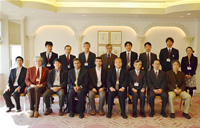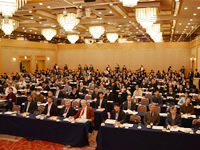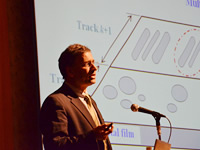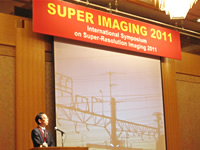



An international symposium on Super-Resolution Imaging 2011, entitled "Super Imaging 2011," was held at Okura Actcity Hotel Hamamatsu on Monday, December 12, 2011. This symposium was held as an enhanced international supportive measure for the CREST research topic, “Electron-beam Excitation Optical Microscopy for High Resolution Imaging” (Representative researcher: Yoshimasa Kawata, Professor of the Faculty of Engineering, Shizuoka University), under the research area, “Enhancing Application of Innovative Optical Science and Technologies by making Ultimate Use of Advanced Light Source.”
This international symposium focused on technologies beyond the resolution limits of optical microscopes, and discussed the current status, potential and applicability of these technologies. As this research area has attracted attention on many fronts due to the various super-resolution technologies proposed for optical microscopes, the symposium had more than 280 participants, including some from universities, laboratories and businesses all over Japan. The large amount of attention this topic is attracting is shown by the fact that there were so many participants, in spite of the fact that it was just a local symposium and was held on only one day. The group also included some participants from abroad, giving the symposium a rich international flavor.
At the symposium, Dr. Winfried Denk, who invented multiphoton excitation microscopy, gave the keynote lecture. Dr. Denk presented a method for analyzing the microstructure of the brain making full use of electron and optical microscopes. Dr. Sako from RIKEN presented a method for observing plasma membrane receptors using localization microscopy, and Dr. Masud Mansuripur gave a lecture on a method for achieving high density optical disk data storage using localized surface plasmon.
Dr. Tony Wilson, who is a pioneer in the field of confocal microscopes, demonstrated methods of high-speed sectioning and focusing of test samples for feasible optical systems, and gave a lecture on their application. Dr. Peter Carlton of Kyoto University presented the fundamental principles and application of high-resolution technology using structured illumination microscopy, and Dr. Nakano of RIKEN presented the results of observation of the Golgi body in cells using a multi-spot confocal microscope which allows for high-speed, high-resolution microscopy. Dr. Michael Hausmann and Dr. Pakorn Kanchanawong gave a presentation on the technology for achieving high resolution using localization microscopy.
Another four lectures were also given on related CREST research areas. The first was a presentation by our team on the principles and experimental results of the resolution evaluation of optical nano-imaging using an electron beam-induced fine light source, the development of which is now being pursued. In addition, Dr. Terakawa of the Hamamatsu University School of Medicine gave a lecture on the results and problems of bio-sample observation, and delivered details of past achievements. Dr. Sato of Tohoku University, who has been working in a research team which is closely related to our team and is engaged in the same research area, gave a lecture on super-resolution technology using vector beams, while Dr. Tanaka of Kyoto University presented the Terahertz Nearfield Imaging method.
Luncheon seminars and exhibits were also held during this symposium, in cooperation with The Japan Society for Laser Microscopy, in addition to other exhibitions by 12 companies. During the intermissions and lunch break, many participants were seen to show an interest in the latest products.
The symposium ended successfully and received a high evaluation, with quite a few of the participants requesting that a second symposium be held in future. It is expected that, with this symposium’s discussions on the status and future of ultra-high resolution technology as momentum, the world’s leading research will make even more progress in the future.
JST, an integrated organization of science and technology in Japan, establishes an infrastructure for the entire process from the creation of knowledge to the return to the society. For more information, visit http://www.jst.go.jp/EN/